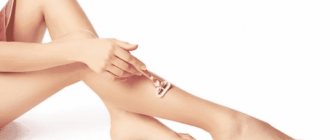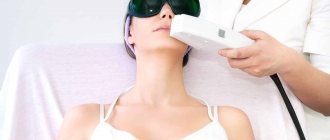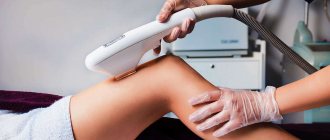Signs of ingrown hairs
Symptoms of improperly growing rods appear 1-3 days after the cosmetic procedure.
Signs of ingrown hairs in the bikini area:
- growth points began to look like pimples, ulcers, bumps, bruises;
- the epilation site is swollen, red or painful;
- inflammation appeared in the bikini area;
- the skin itches or burns after treatment;
- curled hairs or dark spots are visible in the area of discomfort.
Such symptoms cannot be ignored, otherwise the problem of ingrown hair in the bikini area will have to be addressed in the hospital.
After unsuccessful hair removal, it is difficult to avoid the formation of papules (round dense balls) and purulent pimples (pustules). You can get a deformed hair from them.
What is an ingrown hair?
The surface of the skin is normally covered not only with hairs, but also with particles of dead epidermis, which lingers a little on top. As a rule, these tiny particles fall off on their own; sometimes this process is delayed, which leads to the formation of a crust that covers the surface of the hair follicle.
A hair grows from the bulb; if it is covered with a crust, then the rod cannot find a way out and remains under this crust. It cannot stop growing, nor can it get out, so it continues to increase in size under the skin, or is sent back to the bulb.
This whole process is accompanied by severe redness, itching, discomfort, and sometimes low-intensity pain. The area of skin surrounding the follicle may become inflamed, and a decrease in the rate of beard growth in this area is observed.
Important! Dermatologists refer to this problem as curled hair growth, because outside the free space, the hair shaft is forced to grow, twisting in a spiral.
Features of the bikini area
The intimate area is different from other areas where vegetation is removed.
- the hair is very coarse, especially if the lady is naturally dark or red-haired;
- the skin in the bikini area is thin, blood vessels pass close to the surface, and immediately begins to become inflamed;
- high sensitivity in the area between the legs;
- uneven surface for cosmetic procedures;
- constant contact with clothing;
- special, triangular hair structure.
Ingrown hairs are new hair shafts that, as a result of damage to the hair follicle, begin to grow not in the natural direction, but down or to the side. They need to be pulled out from under the skin. Through micro-wounds and cracks in places of growth, microorganisms enter the body, causing pathological processes. All this provokes an inflammatory process that can lead to ulcers, bumps, scars and dark spots.
When epilating, a woman plans to remove hair along with the hair follicles. If something goes wrong, only the shaft and part of the follicle are torn off. As a result of mechanical damage, the position of the hair root changes, and soon a weakened hair appears, which grows not in the intended direction, but in the direction where the bulb has deviated, even growing inside the body. And those rods that do reach the skin, due to thinning, cannot penetrate the epidermis and grow under it, causing inflammation.
How to cure the effects of hair removal or ways to combat it
To prevent the possibility of ingrown hairs and prevent inflammation, several skin care methods are suitable.
How to remove ingrown hairs in the bikini area:
- scrub the skin;
- soften the skin daily with a moisturizer;
- take steaming baths;
- refuse synthetic underwear.
If you prepare in advance for hair removal and grow hairs of sufficient length, this will relieve discomfort and further unpleasant consequences.
If large bumps or ulcers appear, then you need to seek medical help. You cannot remove pus yourself. Skin diseases can only be cured by a dermatologist or surgeon.
What signs indicate the appearance of ingrown hairs?
The appearance of ingrown hairs can be determined by a number of signs:
- the appearance of a tingling sensation;
- severe itching;
- swelling;
- redness of the skin;
- the formation of a lump, in the center of which the head of a hair may appear;
- discharge of pus, appearance of a rash (in especially difficult cases when a bacterial infection is attached).
Sometimes the development of an ingrown hair can be confused with acne. Very often, bumps that form on the surface of the skin resemble pimples, especially when they are filled with pus. Even the slightest touch to the inflamed point can cause obvious pain.
If you leave the process unattended, there is a high probability that an ingrown hair cyst will develop deep under the skin. The only way to get rid of it is through surgery.
It is difficult and dangerous to remove a deeply hidden rod on your own; this can cause infection, leaving scars, scars; if such a situation arises, it is preferable to immediately contact a specialist.
Scrub for ingrown hairs
To better remove follicles, you should treat your body with a fine-grained scrub before going to a cosmetologist. This will help combat the negative consequences of hair removal. The scrubs are simple and easy to use, after which you simply remove the crooked hairs.
Before peeling, steam the skin for 10 minutes by taking a hot bath or applying a damp hot cloth to the removal area. The water can be simply clean, or you can take herbal decoctions.
If there are purulent areas, the scrub cannot be used! You also cannot remove or squeeze out the pus yourself. This will only spread the pathological process over a larger area. This problem should be treated by a dermatologist.
Use pure medicinal herbs or mixtures thereof. Chamomile, celandine, sage, calendula 1 tbsp each. for 0.5 liters of boiling water. Simmer the mixture over medium heat for a quarter of an hour. Leave to cool to 60°C, remove the sediment and wet the fabric for a steaming compress for the bikini area. The heat prevents further damage to the delicate bikini area.
Apply the abrasive mixture to the prepared area and rub the skin with gentle finger movements. Scrub particles remove the microscopic layer of cells, making it softer and thinner; even weakened hairs will be able to break through the treated epidermis. All you have to do is remove the ingrown hair in the bikini area with tweezers. After scrubbing, the body needs to be moisturized by applying cream or cream.
Medicines used to treat ingrown hairs
After visiting a cosmetologist, you may be prescribed some medications that will help get rid of the annoying problem. This list includes:
- • Retinoids. In some situations, the doctor prescribes creams that help remove dead cells from the surface (so-called peeling). These include the drug tretinoin. They help relieve hyperkeratosis, which is thickening, and hyperpigmentation, a darkening of the area that is often seen on dark skin that is prone to ingrown hairs;
• Corticosteroids. A good steroid blend helps control inflammation;
• Antibiotics. Ointments based on antibiotics can prevent infection that occurs due to damage to the painful area. If the infection is severe, oral antibiotics may be prescribed for treatment.
Homemade scrub recipes
To combat the consequences of unsuccessful hair removal, ready-made store-bought or homemade products are suitable. Making a remedy for ingrown pubic hair in the bikini area is easy. Granulated sugar, extra salt, the remains of ground coffee after brewing, finely ground bran, badyagu, grain flakes, and ground medicinal herbs are used as an abrasive. Mix the abrasive component with the viscous base 1:1. The basis is shower gel, cosmetic cream, liquid cream, skin oil.
Such homemade scrubs will help bring the skin back to normal, as in addition to the exfoliating effect, they have a moisturizing, nourishing and anti-inflammatory effect. And herbs will complement the treatment. If you add 1 tsp to the scrub. baking soda, the product is suitable for thick and hard skin. After this, the deformed hairs can only be pulled out with a pin or needle.
Coffee-coconut scrub
This product contains coconut oil, ground coffee, coconut flakes, granulated sugar, and extra salt. Heat the oil until viscous in a water bath. Add the necessary components 1:1, mix thoroughly, cool. To improve the aroma, add cinnamon or vanilla crumbs.
Gentle herbal peeling
The composition includes refined (50 ml) and flavored (1-2 drops each) oils, lemon juice (20 drops) plus ground medicinal herbs and candied honey. The remaining components are mixed in equal proportions and applied to the desired area. This recipe allows you to combine treatment and care.
Healing aloe scrub
Aloe juice or puree (50 g) is mixed with the same amount of coarse corn flour or semolina. This product is delicate, good for the skin, allows you to pull out crooked hairs without discomfort and get rid of wounds.
Read also: Pain-relieving creams and folk remedies for hair removal of the bikini area at home
Powerful aspirin scrub
Crush several tablets of acetylsalicylic acid into grains. Add tablet crumbs to a small amount of liquid soap. Apply the paste with a light massage to the depilation area, avoiding areas with mucous membranes. After a few minutes, rinse off the mixture and wipe the treated area with 3% hydrogen peroxide. Let it dry, rinse off any remaining product, and apply nourishing cream.
Strong whitening peeling
Mix 50 g of white clay with ground parsley. Add a couple of drops of lemon juice. This composition whitens the skin well. It is applied for 10 minutes, after which it is washed off with warm water.
Pulling out lost hairs
After treating the skin with abrasives, ingrown rods will become visible. As long as the surface is steamed and cleaned, removing ingrown hair in the bikini area with tweezers is easy and painless. The damaged bulb will continue to grow a deformed hair for several months, which is pulled out with a needle.
All instruments that come into contact with the body or wounds must be thoroughly wiped with ethanol or another antiseptic (chlorgesidine, myrimistin, hydrogen peroxide).
Skin softening
If you don’t want to deal with ingrown hairs by trying to pull them out with a pin, you can use emollients. To do this, they are applied to the bikini area, the skin becomes thinner, softer, easier to stretch, and the weakened rods quickly pass through the epidermis and are easier to get rid of.
After any traumatic manipulation of the skin, it is necessary to use disinfectants and moisturizers, plus monitor healing for up to 7 days.
Products for softening the epidermis:
- Preparations based on salicylic acid are included in pharmaceutical ointments and cosmetic peels. The site of ingrown hair is treated with an acid solution for 2-5 days, then the hair is simply plucked out with tweezers;
- crushed aspirin tablets in glycerin (2 tablets in 1 tablespoon of oil) are applied pointwise to the ingrown areas, leaving for several hours to soften, then the hair is pulled out;
- mixtures with hydrogen peroxide. Badyagi powder (1:1) is added to the effervescent solution. The resulting composition is applied to the inflamed area for a quarter of an hour for a week or until the ingrown hair appears above the skin.
We must not forget about allergies. When planning a new product or substance, especially in such a delicate area as the bikini, you should first do an allergy test (apply the new product precisely for 20 minutes and note the reaction to it).
What to do with ingrown hairs?
If the problem of ingrown vegetation cannot be avoided, everything possible should be done to correct the current situation. When there is no infection inside the formed lump, you can use one of the methods below.
Methods for getting rid of ingrown hairs:
- Make a compress from herbal decoction. It is possible to prepare a decoction of chamomile, parsley or other herbs that have disinfectant properties. Dip a soft cloth into the prepared, slightly cooled broth, then apply it to the surface of the face. After 10 minutes, the hair can be removed using tweezers (this must be done first to avoid infection). Wipe the damaged area of skin thoroughly with an antiseptic.
- It is not recommended to remove an ingrown hair; it will be much more useful to massage it without unnecessary pressure. To increase its effectiveness, you need to use a scrub, repeating the effect after 1-2 days. You can use a store-bought scrub; it’s not difficult to prepare a homemade version containing coffee grounds, olive oil and a small amount of shower gel.
- The use of salicylic acid will disinfect the inflamed surface, in addition, it helps prevent the formation of scars. Using acid, wipe the affected surface, repeating the effect several times a day. After 4-5 days, the hair will become free and the redness will disappear.
- You need to stop shaving with a razor for a while, or carefully avoid the affected areas. This is necessary so that the skin calms down and does not additionally receive mechanical injuries. For the same reason, you should avoid wearing clothes with a stiff collar.
Self-hair removal can be carried out only if there are no signs of the development of an inflammatory process (the skin area does not contain obvious redness, swelling, or oozing pus). Otherwise, it is better to entrust this procedure to professionals.
Treatment of dark marks from ingrown hairs in the bikini area
After the pimple and hair disappear, a dark spot may remain in its place. A large number of such blue-brown dots and spots look very ugly. You need to try to lighten them.
Ready-made creams and ointments with a whitening effect (zinc-salicylic paste, Badyagi 911 cream) are suitable for this. The drug is applied before bedtime for 15 minutes, for a week or until the darkening disappears. You can get a similar result by rubbing hydrogen peroxide on the spot, but you need to be careful not to burn the skin.
Among home remedies, parsley, milk, fruit acids and white clay have worked well. Using these products it is easy to make masks and compresses. Fruit acids are added to the composition, which will remove darkened spots, remove the rough top layer, cleanse and soften the skin. To do this you need lemon juice, green apple juice, fruit vinegar, plus a base.
An approximate recipe for a solution for whitening the body: mix white clay, an acidic component and essential oil, 1 tbsp each. Apply to problem areas for 10 minutes, rinse, apply nourishing cream.
The parsley mask consists of green gruel (it is better to squeeze the juice out of the greens), lime or lemon juice and kefir. The components are mixed 1:1, applied to the skin, a piece of cloth in this mixture on top, lie down for 20 minutes, then rinse, moisturize with cream. This recipe is also suitable for the face, but use less, you need to focus on the sensations. Wash it off if it starts to burn.
If after masks and compresses with a whitening effect it tingles, the skin can be soothed with baby cream, Bepanten or Panetnol.
Preventive measures
In order not to agonize over the question of how to remove ingrown hair, it is easier to try to prevent the occurrence of this problem by observing preventive measures and performing epilation correctly.
- Before removing vegetation (regardless of the chosen method), it is necessary to clean the skin with gel or soap. After this, it will be correct to use a scrub. It will cleanse the skin of the layer of dead cells and make it smooth.
- Before shaving, be sure to apply foam or gel to the skin. This will not only make the machine glide easier, but will also soften and moisturize the skin.
- Monitor the sharpness of the blade in the razor.
- After shaving, you need to treat the skin with lotion with a disinfectant effect.
- To relieve irritation at the end of the procedure, you need to apply body milk. Instead, you can use anti-ingrowing hair cream after hair removal.
- Unwanted vegetation should not be removed frequently. Especially for those with dry and sensitive skin. Twice a week is considered optimal. Frequent hair removal leads to the appearance of wounds and suppuration, which causes the formation of ingrown hairs.
- Vegetation should be removed only in the direction of its growth.
- Apply anti-ingrown hair cream regularly after hair removal. It removes dead skin cells, thereby softening the skin.
The stratum corneum of the epidermis becomes thinner, which prevents ingrowth. In addition, such creams have a healing effect.
By taking these simple rules as a habit, you can significantly reduce the appearance of ingrown hairs and even forget about this problem forever.










